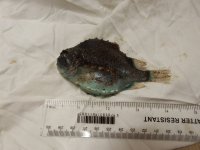Disappointed
I am feeling a little disappointed today. The NSBC annual report for 2017 has arrived at home, but my Balearic Shearwater (see post #205 on pg9) never got past the rarities committee. Instead they have listed it as "Shearwater sp", with the reasoning that it could have been a different Shearwater species.
I understand why, especially as in my description I highlighted my total lack of experience of any Shearwater species. I appreciate their need to maintain the integrity of reporting, but I'm still a bit disappointed, especially as I'm still 100% convinced that it was a Balearic. I suspect that if I had not been able to take a clear photo of last years Grey Phalarope, it too would have just been a "Phalarope sp", so the fault lies in my descriptive abilities.
I am pretty conservative in my reporting because I know that I my lack of experience can lead to mistakes. I have talked myself out of many an ID due to slight niggles in my mind, but I still have none with this Balearic.
Below is the description I sent in. I would be interested in opinion as to whether it could have been a different Shearwater species. My being 100% convinced does not mean I am not 100% wrong.
At 17:15 hours on the 13/05/17, I exited the accommodation block on the Tartan Alpha. The wind was over thirty knots and blowing from the south east. There was some mist on the horizon, however, the sun was shining and visibility was good for several miles around. Reaching the north west corner of the platform at Skid Deck level, I became aware of a dark bird out over the sea. It was noticeably darker than any of the few Fulmars that were around, and it was that, plus its un-gull like flight and light underparts, that drew my attention to it as being something different.
The bird dropped to low over the sea, but then started to rise again in a kind of zig-zagging, wheeling, stiff winged kind of way. By the time it rose above the background horizon line, I had my 8X Monocular on it. One of the first things I noticed when I had the bird in view was the long, thin beak of the bird. It was at this point that I became sure that this was a Shearwater of some kind, so I started making mental notes to aid identification later.
For the minute or two that I had the bird in good view, it continued to drop down then zig-zag by wheeling back and forth to gain height again. All the while moving with the wind away from the platform. As it wheeled back and forth I was able to get good views of both its upper and undersides. The uppersides were a darkish brown, but it was not uniform. It looked a bit patchy, and there were even a few small irregular patches that looked almost faded in a yellowish sort of way. It also become evident at one point that the birds feet were sticking out slightly beyond its tail. On the undersides the belly of the bird was white. Not a bright white, but more of a matt off white. The tail was dark brown, but as you moved from tail to belly the brown colouration diffused into the white. The head of the bird gave the appearance of having a brownish hood, behind which and joined to it was a visible collar. There were no clean lines on the bird between dark and light areas, but the back of the collar came the nearest to that.
Now the underside of the wings. I am not really up on the correct terminology, but in my own words, there was on each wing a central core pale area. A very off white. Around these areas there was a brownish colouration, again inconsistent in shade. The pale areas were separated from all the wing edges and the body by this light brownish colouration that became a little darker towards the wing tips and wing edges, but again, in a diffuse way. The brown colouration certainly extended as far as the body, and may have overlapped onto the body sides.
That is all I can remember. Of one thing I am absolutely, and totally sure of, is the bird was a Shearwater. I have no experience of Shearwaters, but have spent over 24 hours stewing over this bird. I was expecting Manx, however, of the dozens and dozens of photos that I have looked at since seeing the bird, including the Collins Guide, I can’t see past this bird being anything but a Balearic, with the key feature for me being the messy, diffuse colouration especially on the underside of the wings.
I am not sure what to do with my own lists. Probably, I'll annotate the platform list to show the bird only accepted as Shearwater sp, but what do I do with my life list???
:-C






